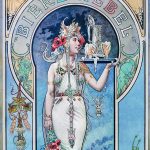Guillaume Charlier, born on July 24, 1854, in Ixelles, Belgium, stands as a pivotal figure in the realm of Belgian sculpture during the late 19th and early 20th centuries. Renowned for his ability to infuse life and emotion into his works, Charlier’s artistic journey unfolded against the backdrop of a dynamic period in art history marked by shifts in style and a growing fascination with expressive sculpture.
Early Artistic Ambitions
Charlier’s journey into the world of art began with early ambitions and a fervent desire to express the human spirit through sculpture. His formal education at the Royal Academy of Fine Arts in Brussels provided him with a solid foundation in classical techniques, setting the stage for the exploration of his own distinctive style.
During his formative years, Charlier demonstrated a predilection for portraying the human form in various emotional states. His sculptures reflected a profound empathy for the human condition, capturing moments of introspection, joy, and melancholy. This early focus on emotional expression would become a hallmark of Charlier’s later works, setting him apart in the evolving landscape of Belgian sculpture.
Monumental Works and Public Recognition
Charlier’s talent and dedication soon earned him public recognition, leading to prestigious commissions for monumental sculptures. Notably, his masterpiece “The Human Passions” (1898), a series of expressive figures representing various emotions, showcased his ability to convey the complexity of the human experience. The installation garnered acclaim for its emotional depth and technical prowess, solidifying Charlier’s reputation as a sculptor of exceptional skill.
The artist’s contributions extended beyond the realm of traditional sculpture, as he embraced the challenges of large-scale public art. Charlier’s statues and memorials adorned public spaces, contributing to the cultural tapestry of Belgium. His commitment to portraying the human spirit with authenticity resonated with both critics and the public, establishing him as a leading sculptor of his time.
Artistic Exploration and Symbolism
As the turn of the century approached, Charlier engaged with the Symbolist movement, aligning his work with the exploration of deeper, often allegorical, meanings. His sculptures took on a symbolic language, delving into themes of spirituality, myth, and the unseen forces that shape human existence. This period of artistic exploration allowed Charlier to transcend the confines of realism and delve into the realms of the symbolic and metaphysical.
One of his notable Symbolist works, “The Genius of Evil” (1895), showcased Charlier’s ability to convey complex narratives through sculpture. The piece, characterized by its evocative symbolism, explored the duality of human nature and the eternal struggle between good and evil. Charlier’s foray into Symbolism added a layer of intellectual depth to his already emotionally charged sculptures, expanding the scope of his artistic expression.
Teaching and Artistic Legacy
Charlier’s influence extended beyond his own creations through his role as a teacher and mentor. His appointment as a professor at the Royal Academy of Fine Arts in Brussels allowed him to impart his knowledge and artistic philosophy to the next generation of sculptors. Charlier’s dedication to education and the nurturing of young talent played a crucial role in shaping the trajectory of Belgian sculpture in the early 20th century.
The legacy of Guillaume Charlier lives on through the works of his students and the continued appreciation of his sculptures. His emphasis on emotion, symbolism, and the exploration of the human psyche left an enduring impact on Belgian sculpture, influencing subsequent generations of artists. Charlier’s commitment to pushing artistic boundaries and delving into the depths of human experience ensures that his name remains synonymous with expressive and thought-provoking sculpture.
Guillaume Charlier passed away on March 10, 1925, leaving behind a body of work that continues to captivate art enthusiasts and scholars alike. His sculptures, characterized by their emotional resonance and symbolic depth, serve as a testament to his enduring contribution to the rich tapestry of Belgian art. Charlier’s legacy endures, not only in the stone and bronze of his sculptures but also in the artistic spirit he instilled in those who followed in his footsteps.




